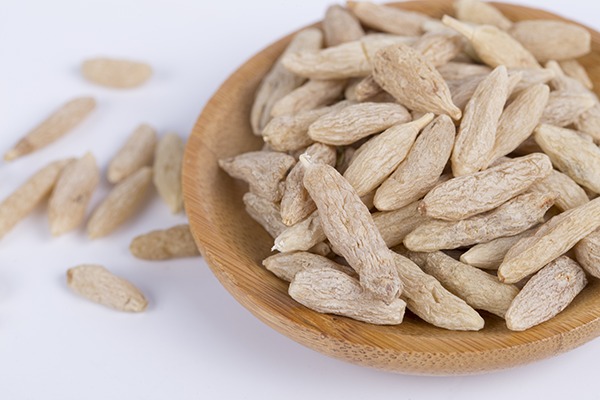This spring, plant an herb that is not only an ornamental but also a powerful medicinal: ophiopogon. Known as Japanese turf lily or mondo grass, it is usually planted as a decorative border for its long, narrow, downward pointing and curling leaves. Few know that the tuber, a small white bulb, is filled with a sweet juice that has many healing properties. In Traditional Chinese Medicine, ophiopogon is classified as a Yin tonic. That means it is cooling and moistening for Heat symptoms due to Dryness and Deficiency, similar to “burn-out,” like running a car low on oil so the engine heats up and eventually burns up. In the body, the person may feel hot or feverish in the evening or night, on and off exhausted, dry burning eyes, dry tongue, mouth and lips (especially at night), a burning sensation in the chest, palms and/or soles of the feet, chronic dry cough, and thirsting and wasting disorders (pre-diabetic and TB-type conditions). I have listed more symptoms of Yin Deficiency here: Yin Deficiency is a lack of cooling, moistening Fluids with resulting depletion (fatigue, exhaustion, emaciation or thinness) along with specific types of Heat and Dryness signs, including: night sweats, malar flush (redness and burning heat along the cheeks and nose), burning sensation in the palms of the hands, soles of the feet and in the chest, afternoon fever or feelings of heat, restless sleep, dry throat or thirst at night, agitation, mental restlessness, dry cough, dry stools, and scanty dark urine. Ophiopogon is specifically used as a Yin tonic to promote the secretion of fluids in treating dry coughs (with or without thick or bloody, difficult-to-expectorate sputum), fevers, palpitations, insomnia, constipation, excessive thirst, and dry throat, tongue, mouth, or stools. I have definitely found it to be the very best herb for a dry cough, either during an acute condition or after. The person usually feels some lung congestion, but the phlegm is difficult to expectorate, or there’s no evidence it’s even present. As well, there’s probably also low energy. Those who have ever experienced Yin Deficient Heat (a dry condition) concurrent with Phlegm (a wet condition) know how tricky treatment of these can be. To have an herb that clears Phlegm while moistening at the same time is a gift indeed. Ophiophogon works brilliantly in these cases because it cools the Heat that dries the Phlegm, making it congeal so it doesn’t expectorate. It also moistens the stuck phlegm, making it easier to pass through and out. Afterward, the person will experience energy again and their chest will feel normal. I’ve also used ophiopogon at the first signs of fever in those with Yin Deficiency as well as the aftermath of those fevers. It is classically used for this in the formula, Ophiopogon Combination (listed below). As well, it is given to moisten the intestines for dry constipation, and treats dry mouth, throat, lips, and eyes. However, it has many other valuable uses. I have found ophiopogon reduces restless leg syndrome, especially at night, to improve low energy (without fever or an acute condition), and to moisten dry, burning eyes (especially at night). It is fabulous for sleep problems as well, when sleep has an “in and out” or trance-like quality so you feel like you’re not asleep and yet you are at the same time. Sometimes it can also help when one wakes at night but has difficulty falling back asleep, particularly if there’s also thirst or a dry mouth/throat present. Whether or not you need ophiopogon’s specific healing properties, it is a beautiful ornamental to have in your garden and you never know when someone else might benefit from it. So plant ophiopogon this year and enjoy its beauty while knowing it holds potent medicine under the ground for those who need it.
Ophiopogon Tuber (Ophiopogon japonicus)
Mai men dong (Chinese) Family: Asparagaceae Also named: Japanese turf lily, turf lily, mondo grass, Ophiopogonis Radix Energy and flavors: Slightly cold, sweet, slightly bitter Organs and channels affected: Lung, Stomach, Heart Chemical constituents: Ruscogenin (steroid sapogenin), B-sitosterol, stigmasterol, B-sitosterol-D-glucoside, ophioside, sugars, mucilage Properties and actions: Tonic, antibacterial, sedative, antitussive, lowers blood sugar, diaphoretic; tonifies Yin Contraindications: Loose stools, acute stages of Wind-Cold pathogenic diseases, Cold or Damp conditions
Ophiopogon Combination (Mai Men Dong Tang)
Ophiopogon (mai men dong) 15–20g Rice, Oryza (jing mi) 15–20g Ginseng, Chinese (ren shen) or American (xi yang shen) 6–9g Pinellia (ban xia) 6–9g Licorice (gan cao) 3–6g Jujube dates (da zao) 5 pieces (As pinellia is only available to practitioners, substitute with chickweed aerial parts (Stellaria media) or marshmallow root (Althaea officinalis). Chinese herb substitutes include glehnia root (Glehnia littoralis – bei sha shen) or lily bulb (Lilium brownie – bai he). Place all ingredients in a pot and cover with 5 cups of water. Simmer until reduced to 2 cups. Strain tea; set liquid aside. Now add 3 cups of water to the cooked herbs and simmer again until reduced to 1 cup. Strain and add liquid to the first 2 cups of tea. Drink 1 cup, three times a day. This formula treats nausea, vomiting, thirst, dry throat and mouth, dry skin, dry, non-productive cough, spitting of saliva, dry mouth and throat, hiccups, five palm heat, red tongue with no coat, and a weak and rapid pulse.

